
|
|
Present at the ConceptionA celebration of the Art Museum's first director Sanford B. D. Low.
By his sonSanford Hart Low. October 25, 2000Edited transcript of a talk presented atthe New Britain Museum of American ArtNew Britain , Connecticut
It's wonderful to be invited by Douglas Hyland and the staff of the Museum to come here and talk to you about my father – Sanford Ballard Dole Low - because it's been an opportunity to go back through all of his files, the letters and the pictures, to present his life - a life that was dedicated to this Museum in so many different ways.
I hear his voice warning me: “look it's not just about me.” That would be the first thing that he would say if he were here to make this presentation. As a young boy at this Museum, I remember so many people who helped my father. They were his extended families - his Ohana - as we say in Hawaiian, and without his Ohana he would not have been able to accomplish all that he did. I remember Flora Bentley who would always be out at the front desk welcoming people to the museum as if it were her home. I remember Harold Gray - a gentleman to the core - a very, very, very warm person. There was Lois Ice Blomstrann, Nancy Cutter, my mother of course - Jinny Low - who was here so much and who constantly supported my father. There was also Helen Vibberts, the patrons, the entire Board of Directors of this Museum, and Dr. John White - who was a Board member and the Museum's historian. I will be drawing from Dr. White's words for this talk. Also Charlie Ferguson, all of the other directors and the staff. All of these people are members of my father's Ohana .
It became clearer and clearer to me - as I put this talk together - that what really allowed Sandy Low to accomplish what he did was that he was Hawaiian. He was a strange cat in ‘The Hardware Capital of the World' and so, as you will see, he was forgiven many transgressions of normal Yankee behavior.
There are a number of Hawaiian concepts that I think are important to understand my father's life. One of them is Ohana , which I have already mentioned. Ohana means “extended family.” It has the sense of your core family but it's extended way, way beyond. It includes all of your friends and meaningful acquaintances. My father also had a sense of aloha – of affection - for just about everybody he met. That innate affection for people allowed him to accept so many into his Ohana , his extended family. Another important Hawaiian concept is the aumakua – the spirits of our ancestors who have gone on before us. Hawaiians believe that these spirits live on and give us the intelligence, the love and the strength to do all that we accomplish in life. My father was born in Hawaii , but spent the better part of his life here in New England . He went through many trials being away from his Hawaiian family but I know that he drew strength from his aumakua - the spiritual family that always accompanied him. And these spirits are here today.
You
often don't really know who your parents are - and you don't know what
their contributions have been - until they are gone. I remember that
the first time I really understood what my father had accomplished with
this Museum was in 1967 when I came here with a friend of mine, Roger
Howlett, from Yale. Roger was a graduate student working on his Ph.D.
in American art. We walked through the front door together. I proceeded
toward the main gallery and realized “I can't move," he said. “What do you mean you can't move”? "I have just walked into this gallery and I have seen some of the best examples of American art that I've ever seen and I can't imagine what I am going to see when I go further” Roger saw two paintings, one of them was this one, a Winslow Homer, Skirmish in the Wilderness , a gorgeous painting. It has a sense of danger, of combat, but also a sense that nature is going to prevail over man's frivolous actions. It's a fantastic painting that was acquired during my father's tenure. It's also rare. Winslow Homer painted very few of these Civil War paintings. Here is another - William Sidney Mount, At the Well - a very peaceful depiction of man and nature. It was at that moment that I began to realize - through the eyes of a friend - what my father had accomplished.
As you know, the Museum was basically founded in 1903 with a grant from John Talcott of $25,000 for the purchase of art. By 1937, when my father began to serve on the Board of Directors, the Museum had only 24 paintings. By the time he died in 1964 there were over 1500 works of art. Going through the Museum's Highlights catalogue, I discovered 79 works of art featured as the best in our collection. Of these, 49 of them were acquired during my father's tenure. Sixty percent of the best art in this museum was acquired during his twenty-five years of service. That attests to his director's eye. I want to start by showing a few examples of the works my father was able to acquire in those twenty-five years.
This museum was the center of my father's creative spirit for the 25 most productive years of his life. When he died an artist said of him, “He did not act like a high priest. He stirred the Museum into the life of the community.” A collector said, “My interest in American art was started and developed through Mr. Low and the Museum. He was warm and democratic with people who came in. If a person was interested in art he gave of himself unstintingly.” And in her obituary Florence Berkman wrote, “Sanford Low showed that a Museum could be not only a repository for great art but a place where the human spirit could be touched and uplifted when its guiding hand is directed by a man who felt deeply that art and life, the fundamental human values, were one, that they had no meaning apart”.
I can hear his voice already; “you're laying it on a bit thick.” Yes I am Dad - but this is your day.
On his mother's side, my father's genealogy can be traced back to one of the great kings of Hawaii , King Kamehameha the First, who unified all the tribes on all the islands. My father was also related by adoption to Sanford Ballard Dole (he was named after him) who supported annexing Hawaii to the United States and served as president of the Republic of Hawaii and Territorial Governor. I think the most important thing, however, is that Sandy Low grew up surrounded by a feeling of aloha (love), in the midst of a large extended family ( ohana ), and acquired a sense of an intimate world filled with friends and relatives – a sense that he carried with him throughout his life.
But more importantly, my father had found his calling. From a letter to his sister Clorinda Lucas, written on March 17, 1924 when he was 19 he said: “Now here's the point. Without a doubt of any kind, the only thing I'll ever succeed in will be the art line. I've been made for it and I can feel it in me.”
In 1927 Sandy graduated from the Museum School . He went on to New York City where he rented a loft at 21 West 35 th Street . While in New York he studied at the Grand Central School of Art and the Art Student League. He spent four years there as a commercial artist.
In those days, you may remember, Gar Wood speedboats were the sleekest and fastest of all - beautiful, slim, powerful boats with a sloped-back windshield. The swains of the day would aquaplane behind such boats to show their prowess. An aquaplane was a board, about six feet long and three wide, which was towed behind the boat at high speed. Just being able to stand up on one of these careening boards was considered the height of masculine showmanship. But dad had been a surfer, a canoe paddler, and a beach boy. He had spent most of his life in the water. So he took aquaplaning one step farther. He stood on his head.
Now it is 1930. Sandy Low has been a commercial artist for four years in New York City . After his marriage, he moved to New Britain , Connecticut – “The Hardware Capital of the World.” What is he going to do here? One of the first things he did was to organize an exhibit his paintings. In January 1930, a few weeks before his marriage, he presented “twenty-two oils, many drawings and imaginative color sketches” at the New Britain Institute. He was invited to exhibit by the famous Fanny Brown who had charge of collections and programs at the New Britain Library – the original home of the Institute.
My father also decided that New Britain needed an art school. The headline from an article in the Sunday Hartford Courant reads: “Grandson of late Hawaiian ruler to be first director of institution which will teach students to paint along original lines.”
The article goes on: “A humble old red barn will soon become the home of New Britain 's first art school. Gone is the quiet that for years has haunted the old building as it stood, silent and ignored, at 30 Cedar Street . Today it echoes the sounds of busy workmen who are reconditioning it for the new and important role it is to play in the city's life. Within it's walls strange changes are taking place. Familiar stalls and stables are being torn away. Partitions are being removed. Rats and mice and cats, tenants of yesterday, have fled in terror before all this confusion. A big studio is being fashioned – a studio in which many future artists of New Britain will receive their first training.” This new institution was known as The Art League of New Britain or, more simply, The Studio.
Supporters of The Art League included Arthur Kimball, Judge Hungerford, William F. Brooks, Mrs. Stanley Hart, Miss Fanny Brown, Wesley Parker, Lawrence Edwardson, Miss Minna Richter, and Earle K. Bishop. Also Grace Vibberts and Margaret Cooper who donated paintings which were raffled off to raise seven hundred dollars for the art school. My father brought in Thomas Craven and William Zorach to lecture and Spencer Nichols and Herbert Meyer to teach art.
Sandy Low and his colleague, Walter Korder, painted dozens of murals at the Art League, beginning in 1937 with a series he called “The Connecticut Murals.” Among them, Walter and Sandy painted a 30-foot piece that was displayed at the New Britain Savings and Loan Association in 1957. As I understand it, the artists charged $5 a square foot. The murals were put up in restaurants, hotels and office buildings.
The Studio at 30 Cedar Street
The Studio transformed the social life of New Britain by bringing together in moments of camaraderie, probably for the first time, artists and people from all walks of life - businessmen, storeowners, lawyers, doctors - all kinds of folks that would normally not have anything to do with artists. The Studio's motto, meticulously painted, presumably by my father, hung prominently over a workbench that also served as an impromptu bar during parties. It read: “welcome all both great and small.” And that's how it was.
The famous art dealer, Bob Vose, said of The Studio: “there was never a dull moment there but many of the anecdotes are too good for recorded history”. And one of the artists who worked at the studio, Ed Conlin (who later became a relative when he married Phronsie Vibberts) said: “ Sandy was always full of wonderful ideas and he had a way of getting people to work with him. They just wanted to be with him. He was full of plots and notions.”
Among those ‘plots and notions' were parties that drew people from far and wide. There were costume parties, ‘casino nights' and even ‘Hawaiian nights' featuring hula dancers – my father's relatives. Word about The Studio spread as far as the Hawaiian Islands and Hawaiian relatives would show up on my parents' doorstep. When Hawaiians come to visit, they don't stay for a day or two, they stay for weeks. Dad and Mom were always glad to have them.
Steven Dohanos, an illustrator for the Saturday Evening Post, was one of Dad's great friends. This is one of Steve's illustrations for The Post. It depicts The Studio and the kind of life that Sanford Low was able to bring to a once decrepit barn. Here he created a new Ohana – a family of business people, professionals and artists - bringing them all together to weave art into the life of New Britain .
Between his arrival in 1930 and 1939, when Sandy Low was nominated to the Board of the New Britain Institute, he was very busy in the local and not-so-local art world. He was co-founder of the Connecticut Watercolor Society and its President for nine years. He was also President of the Association of Connecticut Artists, an elected member of the Salmagundi Club - the oldest art club in the United States – a member of the American Watercolor Society, the New York Watercolor Club and President of the Connecticut Academy of Fine Arts. One of his paintings was selected to represent Connecticut in the 1939 World's Fair.
But the great moment for him came in 1939 (perhaps it was 1937, reports differ) when he was asked to be a member of the Board of Directors of this great Museum. John White, the historian of the Museum wrote this: “I have always thought that the board of the Institute stuck their necks out when they invited Low to become a board member in 1939. He did not fit the standard formula of a board member. They were usually businessmen, or professionals like lawyers or teachers, or bankers, and, if there were a few around, some who might like to leave a bit of money. There was no mistake. They knew him, that he had beefed up the Art League of New Britain and that it had the best parties and shad bakes. And they knew that he belonged to the Connecticut Watercolor Society and was on the board of the Connecticut Academy , and that he had been picked to select artists who would get grants from the WPA. He could bring to the Institute Board just what they needed, someone with know-how and an entrée to the world of the art market and the museum business. What they had not foreseen was that Sandy had the remarkable capacity to fit in, and I think earned their trust and affection.”
The Museum had moved in 1937 to the Landers House. There were only 24 paintings in the collection so there were many empty walls. Having been elected to the Board, one of the first things Sandy thought he should do is go to New York to become acquainted, or perhaps reacquainted, with the directors of other art museums and with art dealers. “My first consideration”, he wrote in a memo to the museum directors, “was to establish relations with those important museums whose art resources could be made available to us in the way of loans”. He visited the Museum of Modern Art , the Whitney, the Milch and Frank Rehn Galleries and eleven other dealers.
He also went to New York with a very well thought-out business plan. At that time there were three ratings that a museum might be given by insurance companies - A, B or C. The New Britain Museum had a B rating, which meant it could only receive loans of paintings up to $2000 in value. When he went to New York , Sandy knew that he had to change that. He visited the Whitney Museum - armed with photographs, drawings and statistics - and convinced them to give the Museum an A rating. That meant that the museum could receive loans of paintings from all over the United States and that's exactly what happened. On that trip, he accomplished two things: to extend the o hana of the Museum to include the great galleries, collectors and dealers in New York and to solve an insurance problem that would allow that ohana to loan paintings of great value to the Museum. He closed his memo to the Board in a typical Sandy Low fashion. He wrote: “Off the record, the weather was frightfully hot, the air-conditioned bars a great relief, and all in all, a trip for which I am truly grateful”.
The
time was ripe when Sandy Low came on to the Museum's Board. American
art, as you know, was then unfashionable so good pieces could be had
for low prices - which was fortunate because that is all the Museum
could pay. Avis Berman, in an article about Dad, wrote: “Low's willingness
to buy the offbeat or unfashionable made him a favorite to dealers who
did not have a lot of customers for this sort of work and preferred
to sell to a museum.” Dad became
Entertainment was a natural part of my father's Hawaiian spirit – his aloha for others – and it was also part of his strategy, I believe, for building a strong ohana of art dealers, artists and museum directors who would help the museum in many ways. As Bob Vose wrote of him: “Of the dozens of times I called at his New Britain Museum with no warning, I can remember no visit that didn't result in an invitation to dinner, no matter whether Jinny (his devoted and long suffering wife) was already expecting guests or whether the dinner hour was only moments away. If the Lows were to be guests at a friends house, Sandy never hesitated to phone his prospective hostess and ask that she set an extra place for me. I've never met another man from whom such requests were not only universally accepted with grace by wife and friends, but almost anticipated.”
There was another side to Dad. He loved practical jokes. Bob Vose and his family were perhaps the most dignified personages you could imagine. They were beyond reproach. Bob's father – Bob Senior - never drank, nor smoked nor swore and wore a coat and tie every moment of the day that he was out of the house. My father, knowing Mr. Vose's tendency to be a little stiff, and wanting to tweak his son, Bob Junior, sent the senior Vose a telegram: “Dear Mr. Vose, your son's name is associated with our Museum in the public mind. His recent carousing in our local nightspots is an embarrassment for this Museum. We are hoping you can curb these excesses.” My father signed the letter formally – “Sanford Ballard Dole Low, Director, New Britain Museum of American Art.” The senior Vose was obviously irate with his son, thinking that he had disgraced the gallery, and it took a bit of time for Junior to convince Senior that it was all a practical joke – that this Hawaiian guy was a little different than normal museum directors.
Here also is Asher B. Durand's Sunday Morning. Purchased in 1963 for $7500 - it is the only painting bought from Vose for over $5000. Durand's son thought that it was one of his father's finest paintings.
Here is Thomas Cole's The Clove, Catskills. In 1912 it sold for $70. It was sold to our Museum in 1945 through the Vose Galleries for $1000. It was reproduced in color by the Metropolitan Museum in the Hudson River School Catalogue and described as “possibly the masterpiece of Cole's early career”. It was shown also at the National Gallery. The Catalogue for that show said that “with this painting Cole has taken his place in a single leap among the great masters of landscape”. The value of this painting today is $4,000,000.
This is Frederic Church's Haying in New Haven , also known as West Rock, New Haven , a painting that was included in the Hudson River School exhibit at the Met and the “Church Show” at the National Gallery. Of this painting, our catalogue says, ““with its beautifully detailed depiction of nature, its lessons about past and present, and its strong personal association for the painter, West Rock, New Haven stands as one of Church's most appealing creations. It was his first masterpiece, one of those key works in an artist's career that not only summarizes all that has gone on before but also announces new interests and predicts new artistic directions.” This painting was sold by Vose to us for $1000 and is today valued at $4,000,000. The dramatic increase in value is an example of what has happened to American art in general but it also shows that Sandy Low had a good eye and that the aloha shared by Vose and Dad produced some amazing results.
One of the single most important events in the history of the Museum was the enlisting of Alix W. Stanley as one of the patrons of this great institution. This ‘enlistment' was accomplished by the partners - Vose and Low. About that seminal event my father wrote in an undated memo, “In 1939 the massing of war clouds in Europe forced the return to New Britain one of her native sons, Alix W. Stanley, a retired wealthy industrialist, who had lived for 15 years on his estate in Southern France . Although previously never interested in art he took it up on his return to this country for want of something to do. As is his custom, anything he does is done completely, sparing no effort or persons. During 1940 it was my good fortune to have a hand in stimulating him into the possibility of buying pictures as a hobby .” What an understatement! But said with proper humility and with a sense of aloha for Alix Stanley, one of the great personages of New Britain .
Bob Vose loves to tell the story of Mr. Stanley's introduction to the art world. It begins when Bob went on a trip throughout much of Connecticut with 7 paintings in his station wagon. It was Christmas Eve, 1941. At the end of the trip, not having sold even a single painting, Bob came to visit my father - probably at The Studio.
Bob told Sandy his story of woe. My father then got a bright idea. He said, “there is a gentleman up on the hill, Alix W. Stanley, a member of the famous Stanley family – the founders of Stanley Works. I've always wanted to get him involved somehow in the Museum. He doesn't like art but he ought to. Let's go visit”. Bob was naturally concerned about calling without a proper introduction, but Sandy was undaunted. They got into Bob's station wagon, drove to Mr. Stanley's house and knocked on the door. As they were waiting for it to open, my father turned to Bob and said, “The old gentleman is a teetotaler. The first thing we're going to do is ask for a drink”.
Mr. Stanley's butler opened the door and Bob and my father slipped inside the Stanley castle for the first time. Eventually, Mr. Stanley came out. Dad introduced Bob Vose as “an expert in American art from the world's most famous American Art gallery.” Before Mr. Stanley could say anything, Dad said “and he needs a drink”. Some moments of confusion followed. There was no booze in the house. Finally, out comes the cook with glasses of cooking sherry - which served the purpose just fine. Eventually, the paintings were brought in and arranged around Mr. Stanley's large parlor - against the wall. My Dad and Bob Vose talked about each painting. At the end Mr. Stanley said, “Well, I don't know anything about paintings, but I thank you very much”.
“Well,” replied my father, “you don't have to worry because I know a lot about art and Mr. Vose knows even more than I do. And these,” he continued, “are wonderful paintings.”
“What do you think I should do?” Mr. Stanley asked, “should I buy some?”
“You should buy them all,” my father answered.
Well he didn't buy them all but he did buy three. One of them is possibly this one - a Hibbard entitled West River Valley Vermont . According to Bob Vose, Mr. Stanley bought a Hibbard, a Vining, and a Waugh. We have one Hibbard in our collection and we can presume it is a gift from Alix W. Stanley.
About that meeting with Mr. Stanley, Bob Vose later wrote: “This was a remarkable example of Sandy 's salesmanship, contagious enthusiasm and complete lack of awe in the presence of older and obviously important people.”
As a result of this first modest purchase of three paintings, Mr. Alix W. Stanley became extremely interested in art. He became an astute collector and he went with my father to New York on many occasions to buy art. He eventually gave a great deal of money to this Museum, including his art collection. Even more importantly, his life took on entirely new depths of meaning. In the end, hebecame an amateur painter himself.
I don't know who else but my father could have accomplished this. I think that Mr. Stanley could feel the aloha that emanated from my father - his sense of joy – and he decided to see what this Hawaiian guy had to offer. I think one of Dad's innate abilities was to involve people in his enthusiasm. But where did he get the chutzpah to so aggressively intrude on Mr. Stanley's privacy? I think that it was important to my father that he was on a mission. I don't think he ever put himself personally forward. I think he did so only when there was a larger purpose - and that larger purpose was to help his friend, Bob Vose, and to bring to the Museum a great new benefactor.
Tom Benton was one of the “regionalist” artists, as you all know. He painted life in America as he saw it. He traveled through our country. He went on canoes, he went on horses, hung out in bars, did what he had to do to put his finger on the pulse of this great nation. He had an amazing, deep, abiding feeling for this country. He pictured life in the raw - dance halls and cowboys, business tycoons and poverty stricken farmers. For a time, he was considered one of our great artists. But he had fallen into disfavor by 1953 when Alix W. Stanley got wind of the possible sale of his murals by the Whitney Museum and told my father about it. The possible acquisition of Benton 's murals fit perfectly my father's strategy for buying. Benton was, as my father wrote, “one of the truly great American artists of this century”. My Dad wanted to acquire good examples of regionalist painting and, because they were out of style at the time, he knew such paintings could be had for bargain prices. He also felt that the murals would appeal to the people of New Britain . “We are in an industrial and farming area,” Dad wrote, “so that I figure they (the murals) will be appreciated and liked by everyone”.
The way that these murals came here was due in part to “the Martha's Vineyard connection” and in part to my father's love of food - a zest for all kinds of cuisine. Dad acquired this taste, I think, from his Hawaiian background. I remember him collecting sea urchins on the beach and eating them raw. When he did this on Martha's Vineyard for the first time it caused immense consternation. His love of food brought my father together with Denys Wortman, a well-known syndicated cartoonist who was also a great cook. Together they cooked turtle soup – which was a failure – and put on a traditional Hawaiian Luau – which was a great success. It was through Denys that my Dad met Tom Benton. At the time, Tom was painting a portrait of Wortman and Wortman, while he was sitting for the portrait, was painting a portrait of Tom. One summer day, Denys invited my father to visit Benton in his studio.
“This was my first visit to Benton 's summer studio and home in the picturesque up-island township of Chilmark , overlooking beautiful Menemsha Pond and Vineyard Sound,” my father wrote of the encounter. “I had some misgivings about the trip. I had long known of his vitriolic attitude toward museums and especially museum directors, the former for their stuffiness and apparent hostility toward the public at large, and the latter for their effete and fashionable art interests and precious mannerisms. He had crossed horns many times with well known museum officials from all over the country, and because of his profane verbosity, colorful phraseology and newsworthy statements, there was always at hand a ready and willing press. There were many who were downright afraid of this little Caesar and others who considered him a braggart, a publicity hound and who did their best to minimize his sincerity by misleading and direct falsehoods concerning the integrity of his art. All this was but fuel to the fire. So I was prepared to meet a formidable person, and I was not disappointed.”
Benton and my father hit it off immediately and in the later years of their friendship, Benton would often visit our home on the Vineyard and in Southington , Connecticut . It was obvious to me, even as a boy of eleven or twelve, that the two men loved to be in each other's company – cooking great feasts, imbibing cocktails, talking art and telling stories.
Sure enough, as my father and the directors of the Museum and everybody associated with this acquisition had predicted, the pendulum of artistic taste began to swing in Benton 's direction. In 1989 there was an 85 painting retrospective of Benton 's work which opened in Kansas City and went on to museums in Detroit , New York and Los Angeles . The centerpiece of the show was the Arts of Life murals. An additional irony was that the Whitney, the Museum, which had deaccessioned the murals 36 years earlier, hosted the show in New York . But this time the paintings were on loan to them - from the New Britain Museum of American Art.
Here is the portrait that Benton did of Wortman (left). And this is the portrait that Wortman did of Benton (right). These two paintings are here in this museum as well and they are actually what my father was after when he visited Benton in 1952. He had no idea then that he was going to acquire the wonderful murals as well. Nor could he have predicted in 1941, when he first visited Alix W. Stanley, that Mr. Stanley would play such an important role in discovering the murals in the first place.
The last thing I want to imply in this small talk is that my father was a successful museum director purely because he was, as Tom Benton said of him, “a good red blooded American” – albeit a Hawaiian-American. The power of his personality was formidable, to be sure, inspiring Judith Brown to write of him in her loving remembrance after he died that “to be sitting in the company of Sanford Low even for a few hours was like sitting before a glowing fireplace on a chilly evening.” But my father also had a formidable eye for the best in art and a keen mind which he schooled himself – much as Tom Benton did – by reading avidly, and studying, and being a good listener.
I'll give you some examples of the art that was acquired under his tutelage. This is the Le Jour du Grand Prix, one of my father's favorite prizes - by Childe Hassam - bought from the 57 th Street gallery in June of 1943. Of this gratifying purchase, my Dad wrote, “this canvas is quite large, 36” x 48”, (and it) portrays in Hassam's best Impressionist style, the color, gaiety and excitement of race day in Paris around the turn of the century. It was the best painting of his that I have ever seen, and expensive according to our budget but of a quality I could not ignore. The painting was shipped to New Britain , passed on and purchased for $4,000.” Three months later my father was approached by an agent representing a buyer and he was offered $10,000 for the painting. When he refused, the amount was doubled. He refused again. “The painting,” Dad wrote in 1956, “still rates among the top ten of his (Childe Hassam's) finest works and we are very proud to own it.”
Here is John Stuart Curry's The Black Stallion , a gift to the Museum from Steve Dohanos, one ofmy father's great friends.
Here is Norman Rockwell's Weighing In . Judy Brown says that this painting was a personal gift of the artist. According to her recollection, Norman Rockwell appeared at the Museum with this piece of work under his arm, wrapped up in plain, brown paper. Dad wasn't there so he simply left it for him.
Here is N.C. Wyeth, my mother's favorite illustration in our collection. It's a great example, “ One More Step Mr. Hands” .
This is Charles Burchfield's Lavender and Old Lace. This is a painting my father often pointed out to e. As a young boy I was not terribly interested in art, but this one did capture my attention. I'm sure he knew it would. Anybody can be moved by this painting. I've never forgotten it.
Here is John Haberle's Time and Eternity . Bob Vose mentions that Sandy and John were good friends and that Dad took Mr. Vose many times to John's studio in New Haven .
Here are two more wonderful works acquired by my father for the museum - Maurice Prendergast's Beechmont - and this one, Andy Wyeth's, McVey's Barn .
He had so much to give – and gave so lavishly He found so much to love and loved so well not just the people who made up his friendly world not only family, dogs and cherished home but sun and sky and countryside were his he made them in some SPECIAL way his own. Through his awareness we became aware of all the country things he sensed and loved the fields and orchards, David up the road, stonewalls and woodpiles and flight of autumn geese the thud of apples from a windy tree. He loved the sweep and beauty of new england snows, the joyous flight of little winter birds outside his window by the banquet apple tree. In spring the sweet wild strrawberries in upland fields and planked shad cooking on a charcoal fire on rocky hillside just below the house, where spring with tender misty green had just begun. And then the sea. He'd known a warm and distant sea in boyhood. then he learned to know and love our own Atlantic and colder northern shore. through all his life he held the world so close he built of it a steadfast continuity a strong unbroken and coherent whole. His, warmth, his robust humor and vitality somehow rubbed off on us who knew him well. In knowing him we too became in some sure way more vital and more friendly and more kind. Dear sandy, may the winds and tides be fair to take you where you go. Of this be sure – our love goes with you and our gratitude.
I think that says it all and I'll stop here. That poem is a gift of love to my father from one of his great friends. And this museum was my father's gift of love to all of us.
|
Sam Low.com home | Biography | Library | Gallery | Screening Room | Forbears | Notebook | Contact Sam
Site, text, and images Copyright © 2002 Sam Low. All rights reserved. Any or all content may not be used without Sam's permission.

 after
a few paces that my friend wasn't with me anymore. I looked back.
after
a few paces that my friend wasn't with me anymore. I looked back.  This
is George Bellows, The Big Dory , acquired in 1944. Other examples
are Robert Henri, Spanish Girl of Segovia , 1941; John Sloan,
Main Street, Gloucester , 1943; Thomas Moran, The Wilds
of Lake Superior , 1944; Rockwell Kent, Toilers of the Sea
, 1944; William Harnett, Still life with Violin, 1942;
and something totally different, Benjamin West, Thetis Bringing
the Armor to Achilles , 1942.
This
is George Bellows, The Big Dory , acquired in 1944. Other examples
are Robert Henri, Spanish Girl of Segovia , 1941; John Sloan,
Main Street, Gloucester , 1943; Thomas Moran, The Wilds
of Lake Superior , 1944; Rockwell Kent, Toilers of the Sea
, 1944; William Harnett, Still life with Violin, 1942;
and something totally different, Benjamin West, Thetis Bringing
the Armor to Achilles , 1942.  So
who was he? Dad was born on September
21, 1905 in Kohala , Hawaii . This is a picture of him taken
when he was 18 or 19. You can see the Hawaiian mountains behind him
and you can also see that he was a very Hawaiian looking young man.
His father was known as Rawhide Ben Low - one of Hawaii 's most famous cowboys. In Hawaii you can still find some of the largest
ranches in the United States and Rawhide Ben was born on one of them, the Parker Ranch. His father,
John Somes Low, came to the islands from Gloucester in 1850.
So
who was he? Dad was born on September
21, 1905 in Kohala , Hawaii . This is a picture of him taken
when he was 18 or 19. You can see the Hawaiian mountains behind him
and you can also see that he was a very Hawaiian looking young man.
His father was known as Rawhide Ben Low - one of Hawaii 's most famous cowboys. In Hawaii you can still find some of the largest
ranches in the United States and Rawhide Ben was born on one of them, the Parker Ranch. His father,
John Somes Low, came to the islands from Gloucester in 1850.  In
1921, Sandy Low was sent away to Loomis School in Windsor , Connecticut to gain an experience of the world
beyond Hawaii :
to learn something of art, history, literature and science. He had a
wonderful time on the Lurline, the steamer that sailed from Hawaii to San
Francisco . He formed a band that
played every night in the ship's bar. He came across country by rail
and arrived at Loomis School one fall day. Shortly thereafter,
he wrote to his sister in Hawaii : “I arrived safely at Loomis and
have come to the conclusion that this is a hell of a place. I'd have
given anything to be back home again. I'm not real homesick, but I feel
rotten. I miss everybody. I'd like to beat it but I guess I'll stick.
I've been here one night and I nearly froze.” Not a very promising beginning
for a man who was to spend the rest of his life in New
England . He played on the school's
varsity football team – halfback – in his bare feet. He stayed at Loomis
for 3 months - until the snow flew. Then, with homesickness so strong
he couldn't stand it anymore - he ran away. He took a freight train
(he jumped on one) and went to visit relatives in Long
Island . He had a dream of being
“a cartoonist.” He wanted to draw sketches, do caricatures. So, having
abandoned highschool in his freshman year, he found himself at the Museum School in Boston , one of the finest art schools in
the United States .
He was to spend four years there.
In
1921, Sandy Low was sent away to Loomis School in Windsor , Connecticut to gain an experience of the world
beyond Hawaii :
to learn something of art, history, literature and science. He had a
wonderful time on the Lurline, the steamer that sailed from Hawaii to San
Francisco . He formed a band that
played every night in the ship's bar. He came across country by rail
and arrived at Loomis School one fall day. Shortly thereafter,
he wrote to his sister in Hawaii : “I arrived safely at Loomis and
have come to the conclusion that this is a hell of a place. I'd have
given anything to be back home again. I'm not real homesick, but I feel
rotten. I miss everybody. I'd like to beat it but I guess I'll stick.
I've been here one night and I nearly froze.” Not a very promising beginning
for a man who was to spend the rest of his life in New
England . He played on the school's
varsity football team – halfback – in his bare feet. He stayed at Loomis
for 3 months - until the snow flew. Then, with homesickness so strong
he couldn't stand it anymore - he ran away. He took a freight train
(he jumped on one) and went to visit relatives in Long
Island . He had a dream of being
“a cartoonist.” He wanted to draw sketches, do caricatures. So, having
abandoned highschool in his freshman year, he found himself at the Museum School in Boston , one of the finest art schools in
the United States .
He was to spend four years there.  This
is a rather unusual picture for an art school – perhaps the only photograph
of an art school football team – a team inspired by Sanford Ballard
Dole Low. Charles Mahoney, a friend of Dad's wrote about the team in
a memoir of that period: “ Sandy was very popular with everyone.
He had a warm, infectious smile. In 1925 we organized the first, and
maybe the only, art school football team. Sandy was our leader and star. With him,
our success was assured. When we graduated there were no more football
teams at the Museum School .”
This
is a rather unusual picture for an art school – perhaps the only photograph
of an art school football team – a team inspired by Sanford Ballard
Dole Low. Charles Mahoney, a friend of Dad's wrote about the team in
a memoir of that period: “ Sandy was very popular with everyone.
He had a warm, infectious smile. In 1925 we organized the first, and
maybe the only, art school football team. Sandy was our leader and star. With him,
our success was assured. When we graduated there were no more football
teams at the Museum School .”  This
is a painting of my father - probably by one of his art school colleagues.
Clorinda Lucas, his sister, showed up one day at his New
York studio and found a Stutz Bearcat
– an expensive automobile - parked outside. She said, “ Sandy , whose car is that?” He said, “Oh,
it's mine.” That was, of course, untrue. He had been loaned the car
by a wealthy admirer - an attractive young woman, I assume. During his New York period, Sandy Low became somewhat of a celebrity out on Long
Island where he would be invited
to a variety of parties.
This
is a painting of my father - probably by one of his art school colleagues.
Clorinda Lucas, his sister, showed up one day at his New
York studio and found a Stutz Bearcat
– an expensive automobile - parked outside. She said, “ Sandy , whose car is that?” He said, “Oh,
it's mine.” That was, of course, untrue. He had been loaned the car
by a wealthy admirer - an attractive young woman, I assume. During his New York period, Sandy Low became somewhat of a celebrity out on Long
Island where he would be invited
to a variety of parties. 



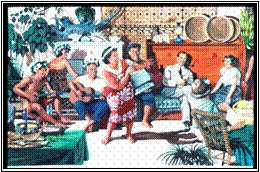
 a
bargain hunter with a trained artist's eye and a personality that endeared
him to just about everyone he met. In a memoir of these times, my father
wrote of his search for exceptional art: “We are in the arduous business
of buying culture by the square foot or square inch of painted or drawn
surfaces, by old and new masters, some conservative, others modern...
We do not have the fortune of a Mellon or a Chrysler to encourage a
stab at the five or six figure masterpieces that come on the market
from time to time. We must be content to explore on our own, to investigate
the tip from a friendly art dealer interested in the quality of our
collection, or the hope for the discovery of a young and new talent,
or the uncovering of a long lost masterpiece – all within our modest
means.” My mother said of this time, “ Sandy jumped into all of this
so unexpectedly. He went to New York , read and entertained a great
deal when dealers came to New Britain .”
a
bargain hunter with a trained artist's eye and a personality that endeared
him to just about everyone he met. In a memoir of these times, my father
wrote of his search for exceptional art: “We are in the arduous business
of buying culture by the square foot or square inch of painted or drawn
surfaces, by old and new masters, some conservative, others modern...
We do not have the fortune of a Mellon or a Chrysler to encourage a
stab at the five or six figure masterpieces that come on the market
from time to time. We must be content to explore on our own, to investigate
the tip from a friendly art dealer interested in the quality of our
collection, or the hope for the discovery of a young and new talent,
or the uncovering of a long lost masterpiece – all within our modest
means.” My mother said of this time, “ Sandy jumped into all of this
so unexpectedly. He went to New York , read and entertained a great
deal when dealers came to New Britain .” 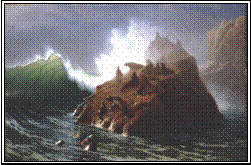
 Martha's
Vineyard Island was one of Dad's favorite places
in New England .
He discovered there a way of life that reminded him of his beloved Hawaiian
Islands . He fished, he enjoyed the
ocean. He gathered together a group of artists, shown in this photograph.
Steven Dohanos(third from left) is a well-known illustrator and a benefactor
of this Museum. The pugnacious, tough-looking gentleman (fourth from
right) is Jim Cagney – the actor. Jim painted as well acted. He lived
on Martha's Vineyard in the summer, and somehow my father and he got together and Cagney
became a member of the Vineyard artist's group. Here is Louis Fusari
(second from left), an art teacher and a fine restorer of paintings;
Irving Katzenstein (last on right), artist; Walter Korder, Dad's partner
in mural painting (third from right); and also Mr. Ned Allen (second
from right), amateur artist and owner of the fine Hartford department store – Sage Allen. It
was a group of people “both great and small.” Welcome all!
Martha's
Vineyard Island was one of Dad's favorite places
in New England .
He discovered there a way of life that reminded him of his beloved Hawaiian
Islands . He fished, he enjoyed the
ocean. He gathered together a group of artists, shown in this photograph.
Steven Dohanos(third from left) is a well-known illustrator and a benefactor
of this Museum. The pugnacious, tough-looking gentleman (fourth from
right) is Jim Cagney – the actor. Jim painted as well acted. He lived
on Martha's Vineyard in the summer, and somehow my father and he got together and Cagney
became a member of the Vineyard artist's group. Here is Louis Fusari
(second from left), an art teacher and a fine restorer of paintings;
Irving Katzenstein (last on right), artist; Walter Korder, Dad's partner
in mural painting (third from right); and also Mr. Ned Allen (second
from right), amateur artist and owner of the fine Hartford department store – Sage Allen. It
was a group of people “both great and small.” Welcome all!  In
their forty or so years of visual explorations, the Vineyard artists
came back with scenes of beaches, boats, houses, lobster pots, gulls,
fishermen... They painted in all kinds of weather. At the end of their
stay, they displayed their work on the porch of our gingerbread house
in Harthaven, on the Vineyard. Most everyone in Harthaven came to drink
gin and tonics and old-fashioneds and admire the paintings.
In
their forty or so years of visual explorations, the Vineyard artists
came back with scenes of beaches, boats, houses, lobster pots, gulls,
fishermen... They painted in all kinds of weather. At the end of their
stay, they displayed their work on the porch of our gingerbread house
in Harthaven, on the Vineyard. Most everyone in Harthaven came to drink
gin and tonics and old-fashioneds and admire the paintings. 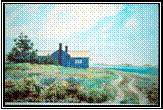
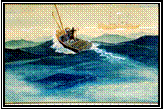 Here
are a few examples of my father's paintings. He began working in oils,
and then became a well known watercolorist. He experimented with acrylics
and even with wood sculpture.
Here
are a few examples of my father's paintings. He began working in oils,
and then became a well known watercolorist. He experimented with acrylics
and even with wood sculpture. 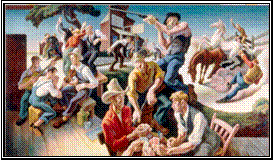 The
Vineyard connection led to what I suppose to be one of the most amazing
acquisitions of a work of art by a small museum – or maybe even a large
one - the story of the Benton Murals which were acquired from the famous Whitney Museum in New
York . I am going to begin with the
words of Avis Berman from a 1992 article in the Magazine of the Hartford
Courant . To get the murals out of the Whitney, my Dad had to take
out a skylight, hire a crane, and go there personally. This is how Avis
describes the caper: “ New York City , December 1953,” she wrote. “Five
or six men are loading a crate parked at 10
West 8 th Street in the heart of Greenwich Village .
Four large, heavy, murals, canvas on masonite panels, crossed in the
back with 2 x 4's and 2 x 6's, are being hoisted through the skylight
of a nearby building and lowered to the street. Grunting and sweating
the men finally get all the panels into their truck. Their leader, Sanford
Low, inspects the job, gives his okay and climbs into the cab. The vehicle
heads north as quickly as possible as if the driver fears that the occupants
of the building would claim the cargo if they had time”. And indeed,
as it turns out, well they might have.
The
Vineyard connection led to what I suppose to be one of the most amazing
acquisitions of a work of art by a small museum – or maybe even a large
one - the story of the Benton Murals which were acquired from the famous Whitney Museum in New
York . I am going to begin with the
words of Avis Berman from a 1992 article in the Magazine of the Hartford
Courant . To get the murals out of the Whitney, my Dad had to take
out a skylight, hire a crane, and go there personally. This is how Avis
describes the caper: “ New York City , December 1953,” she wrote. “Five
or six men are loading a crate parked at 10
West 8 th Street in the heart of Greenwich Village .
Four large, heavy, murals, canvas on masonite panels, crossed in the
back with 2 x 4's and 2 x 6's, are being hoisted through the skylight
of a nearby building and lowered to the street. Grunting and sweating
the men finally get all the panels into their truck. Their leader, Sanford
Low, inspects the job, gives his okay and climbs into the cab. The vehicle
heads north as quickly as possible as if the driver fears that the occupants
of the building would claim the cargo if they had time”. And indeed,
as it turns out, well they might have. 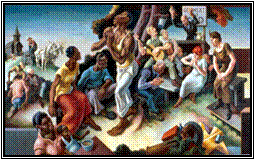 About
the act of creating murals such the ones we have in our collection,
I want to read you a quote from Benton that appears in his book – “An
Artist in America . “The very thought of the large spaces puts me in
an exalted state of mind, strings up my energies, and heightens the
color of the world,” Benton wrote. “After I have gone through practical
preparations, which are elaborate and occupy the major part of the time
spent on any job, a certain kind of thoughtless freedom comes over me.
I don't give a damn about anything. Once on the wall, I paint with downright
sensual pleasure. The colors I use make my mouth water. The sweep of
my brushes, after I really get started, become precise and somehow or
other beyond error. I get cocksure of mind and temperamentally youthful.
I run easily into childish egomania or adolescent emotionalism. When
the mural is finished I have a great letdown.”
About
the act of creating murals such the ones we have in our collection,
I want to read you a quote from Benton that appears in his book – “An
Artist in America . “The very thought of the large spaces puts me in
an exalted state of mind, strings up my energies, and heightens the
color of the world,” Benton wrote. “After I have gone through practical
preparations, which are elaborate and occupy the major part of the time
spent on any job, a certain kind of thoughtless freedom comes over me.
I don't give a damn about anything. Once on the wall, I paint with downright
sensual pleasure. The colors I use make my mouth water. The sweep of
my brushes, after I really get started, become precise and somehow or
other beyond error. I get cocksure of mind and temperamentally youthful.
I run easily into childish egomania or adolescent emotionalism. When
the mural is finished I have a great letdown.” 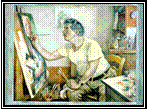
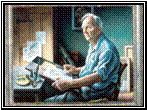
 Tom
Benton and my father became great friends. This photograph was probably
taken in Dad's office at the Museum in 1953. It shows the two of them
in a characteristic moment - drinks in hand, laughing together. “Your
father is the damndest Museum
director I've ever known,” Benton
once said to me. “For one thing, he's an
artist himself, he's also a person who knows about art and art history,
he's got a good eye, and he likes bourbon almost as much as I do”.
Tom
Benton and my father became great friends. This photograph was probably
taken in Dad's office at the Museum in 1953. It shows the two of them
in a characteristic moment - drinks in hand, laughing together. “Your
father is the damndest Museum
director I've ever known,” Benton
once said to me. “For one thing, he's an
artist himself, he's also a person who knows about art and art history,
he's got a good eye, and he likes bourbon almost as much as I do”. 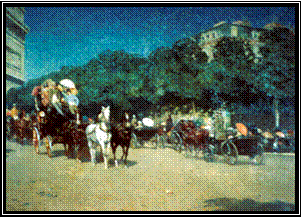
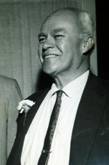 As
you all know, Dad was present in 1964 when the Philip Bartholomew Stanley
Memorial Wing was opened to house Tom Benton's murals and lithographs
and he died two days later. I would like to read, if I can, a poem by
Kay Schauffler who was one of Dad's great friends. I think it sums up
all that I have been trying to say of my father. It unconsciously embodies
his Hawaiian reverence for the aumakua - the ancestors; his
warm sense of the o hana - the extended family; and my father's
feeling of aloha - the spirit of love that infused his life.
I'm not sure I can do this. I've tried it, rehearsed it. We'll see.
As
you all know, Dad was present in 1964 when the Philip Bartholomew Stanley
Memorial Wing was opened to house Tom Benton's murals and lithographs
and he died two days later. I would like to read, if I can, a poem by
Kay Schauffler who was one of Dad's great friends. I think it sums up
all that I have been trying to say of my father. It unconsciously embodies
his Hawaiian reverence for the aumakua - the ancestors; his
warm sense of the o hana - the extended family; and my father's
feeling of aloha - the spirit of love that infused his life.
I'm not sure I can do this. I've tried it, rehearsed it. We'll see.